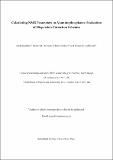Files in this item
Calculating NMR parameters in aluminophosphates : evaluation of dispersion correction schemes
Item metadata
| dc.contributor.author | Sneddon, Scott | |
| dc.contributor.author | Dawson, Daniel M. | |
| dc.contributor.author | Pickard, Chris J. | |
| dc.contributor.author | Ashbrook, Sharon E. | |
| dc.date.accessioned | 2014-12-13T00:01:35Z | |
| dc.date.available | 2014-12-13T00:01:35Z | |
| dc.date.issued | 2014-02 | |
| dc.identifier | 99821702 | |
| dc.identifier | 10a5fc5a-7993-4935-b9e0-0e7ee34d5bab | |
| dc.identifier | 000329926700048 | |
| dc.identifier | 84892592612 | |
| dc.identifier | 000329926700048 | |
| dc.identifier.citation | Sneddon , S , Dawson , D M , Pickard , C J & Ashbrook , S E 2014 , ' Calculating NMR parameters in aluminophosphates : evaluation of dispersion correction schemes ' , Physical Chemistry Chemical Physics , vol. 16 , no. 6 , pp. 2660-2673 . https://doi.org/10.1039/c3cp54123a | en |
| dc.identifier.issn | 1463-9076 | |
| dc.identifier.other | ORCID: /0000-0002-4538-6782/work/56639004 | |
| dc.identifier.other | ORCID: /0000-0002-8110-4535/work/34029123 | |
| dc.identifier.uri | https://hdl.handle.net/10023/5920 | |
| dc.description.abstract | Periodic density functional theory (DFT) calculations have recently emerged as a popular tool for assigning solid-state nuclear magnetic resonance (NMR) spectra. However, in order for the calculations to yield accurate results, accurate structural models are also required. In many cases the structural model (often derived from crystallographic diffraction) must be optimised (i.e., to an energy minimum) using DFT prior to the calculation of NMR parameters. However, DFT does not reproduce weak long-range "dispersion'' interactions well, and optimisation using some functionals can expand the crystallographic unit cell, particularly when dispersion interactions are important in defining the structure. Recently, dispersion-corrected DFT (DFT-D) has been extended to periodic calculations, to compensate for these missing interactions. Here, we investigate whether dispersion corrections are important for aluminophosphate zeolites (AlPOs) by comparing the structures optimised by DFT and DFT-D (using the PBE functional). For as-made AlPOs (containing cationic structure-directing agents (SDAs) and framework-bound anions) dispersion interactions appear to be important, with significant changes between the DFT and DFT-D unit cells. However, for calcined AlPOs, where the SDA-anion pairs are removed, dispersion interactions appear much less important, and the DFT and DFT-D unit cells are similar. We show that, while the different optimisation strategies yield similar calculated NMR parameters (providing that the atomic positions are optimised), the DFT-D optimisations provide structures in better agreement with the experimental diffraction measurements. Therefore, it appears that DFT-D calculations can, and should, be used for the optimisation of calcined and as-made AlPOs, in order to provide the closest agreement with all experimental measurements. | |
| dc.format.extent | 14 | |
| dc.format.extent | 8888921 | |
| dc.language.iso | eng | |
| dc.relation.ispartof | Physical Chemistry Chemical Physics | en |
| dc.subject | Negative thermal-expansion | en |
| dc.subject | Quantum MAS NMR | en |
| dc.subject | Molecular-sieve | en |
| dc.subject | 1st-principles calculations | en |
| dc.subject | Quadrupolar nuclei | en |
| dc.subject | Resolution | en |
| dc.subject | Framework | en |
| dc.subject | Diffraction | en |
| dc.subject | Phosphate | en |
| dc.subject | Spectroscopy | en |
| dc.subject | QD Chemistry | en |
| dc.subject.lcc | QD | en |
| dc.title | Calculating NMR parameters in aluminophosphates : evaluation of dispersion correction schemes | en |
| dc.type | Journal article | en |
| dc.contributor.sponsor | EPSRC | en |
| dc.contributor.sponsor | EPSRC | en |
| dc.contributor.sponsor | EPSRC | en |
| dc.contributor.sponsor | EPSRC | en |
| dc.contributor.sponsor | EPSRC | en |
| dc.contributor.institution | University of St Andrews. School of Chemistry | en |
| dc.contributor.institution | University of St Andrews. EaSTCHEM | en |
| dc.identifier.doi | https://doi.org/10.1039/c3cp54123a | |
| dc.description.status | Peer reviewed | en |
| dc.date.embargoedUntil | 2014-12-13 | |
| dc.identifier.grantnumber | EP/E041825/1 | en |
| dc.identifier.grantnumber | EP/J010510/1 | en |
| dc.identifier.grantnumber | EP/J501542/1 | en |
| dc.identifier.grantnumber | EP/J501542/1 | en |
| dc.identifier.grantnumber | EP/J501542/1 | en |
This item appears in the following Collection(s)
Items in the St Andrews Research Repository are protected by copyright, with all rights reserved, unless otherwise indicated.

